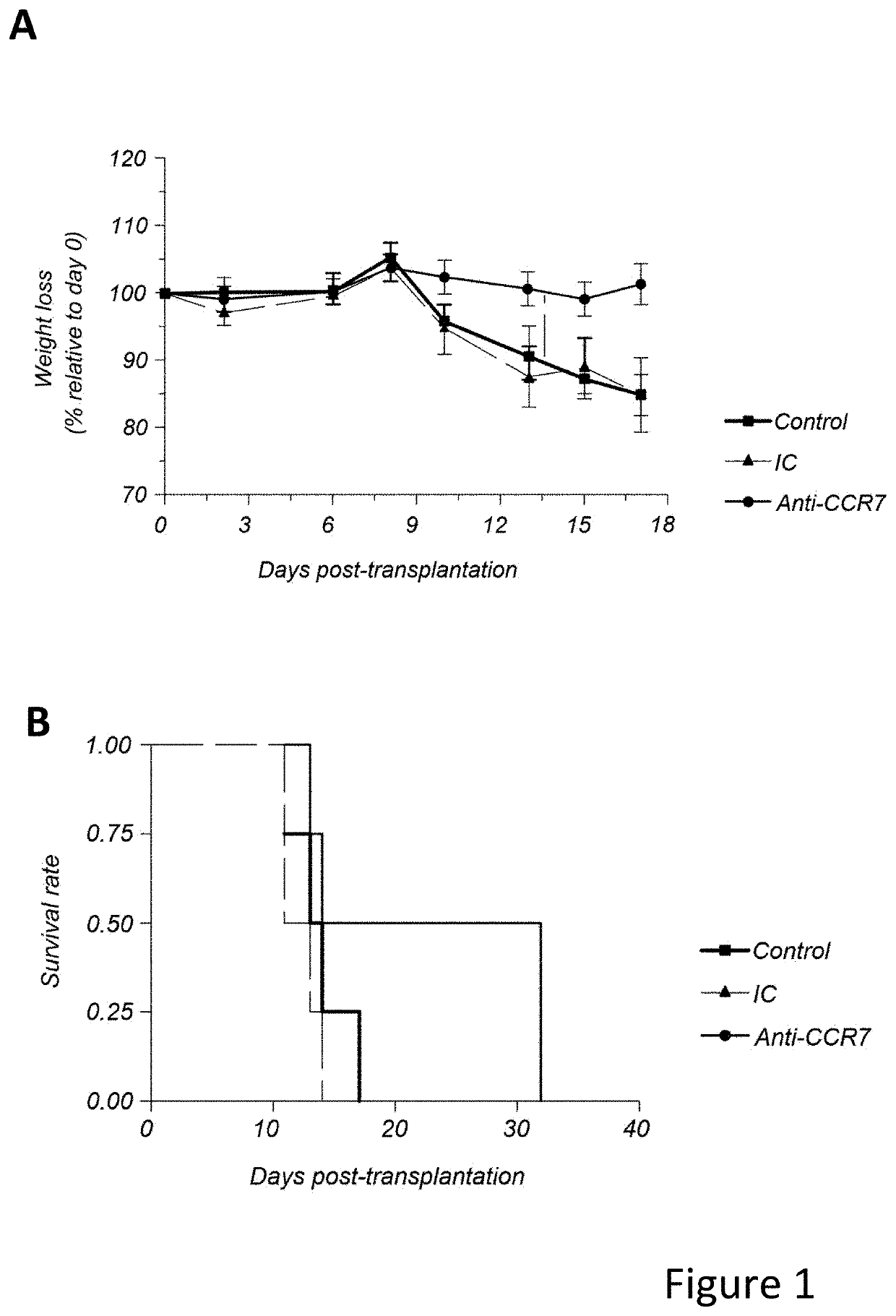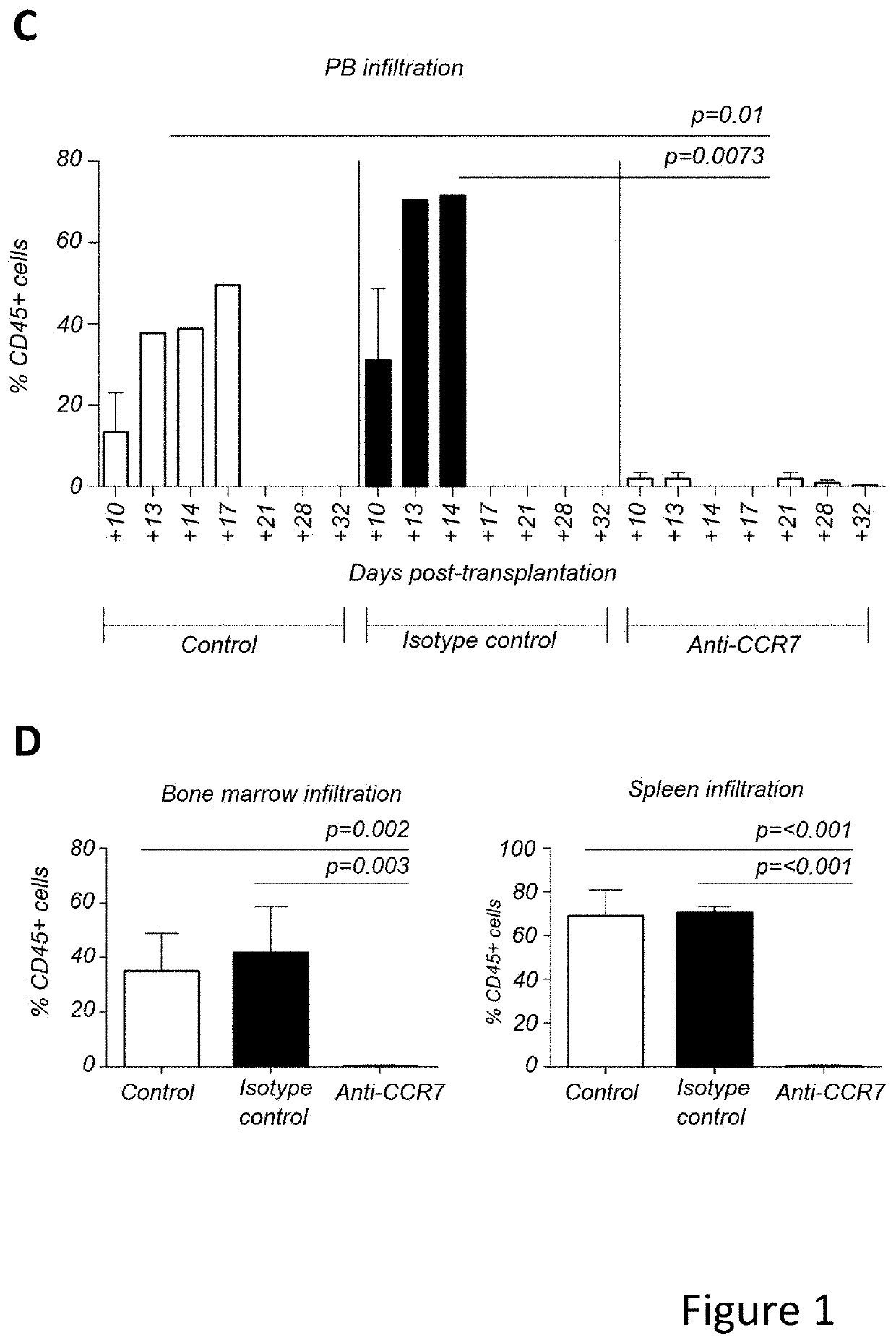The use of anti-CCR7 mabs for the prevention or treatment of graft-versus-host disease (GvHD)
a technology of graft-versus-host disease and anti-ccr7, which is applied in the field of medicine and pharmacy, can solve the problems of significant morbidity and mortality, inability to detect ccr7 receptors, and blurred temporal distinction, and achieve the effect of maintaining or promoting the graft-versus-tumour effect or the graft-versus-leukaemia
- Summary
- Abstract
- Description
- Claims
- Application Information
AI Technical Summary
Benefits of technology
Problems solved by technology
Method used
Image
Examples
example 1
s to CCR7 as a Tool for Treating GVHD
Material and Methods
Samples, Reagents and Flow Cytometry (FCM)
[0148]Peripheral blood samples from healthy volunteers were obtained after informed consent. Analysis of CCR7 expression was subsequently performed on normal T and B lymphocytes. Phycoerythrin (PE)-conjugated mouse anti-human CCR7 was purchased from R&D Systems (McKinley Place, Minn.). In all cases appropriate isotype controls (IC) were included. Immunofluorescence staining was analyzed on a FACS CANTO II flow cytometer using DIVA software (BD Biosciences). Peripheral blood mononuclear cells (PBMC) were isolated by ficoll gradient centrifugation (Histopaque-1077, Sigma-Aldrich, Madrid, Spain).
Xenogeneic Mouse Model of GVHD
[0149]GVHD in vivo models were developed in NOD / SCID-IL2Rγnull mice. To this end, in all models animals were sub-lethally irradiated with 2 Gy, and 4 hours later, 8×106 human peripheral blood mononuclear cells (PBMC) from healthy volunteers (in 200 μl of PBS) were int...
example 2
ation of Patients Having Low Risk of GVHD
Material and Methods
[0170]We analyzed a cohort of 103 donor-recipient pairs (see Table 2) who underwent allo-HSCT at the La Princesa University Hospital, Madrid, Spain (Portero-Sainz et al, 2017). The study protocols were approved by the Ethics Committee (Reference PI-624) and performed in accordance with the Declaration of Helsinki.
TABLE 2Transplant characteristicsTransplant characteristicsno. of patients (%)Recipients age, years 0-202(2%)21-3013(13%)31-4021(20%)41-5026(25%)51-6025(25%)>6016(15%)Diagnosis of the underlyingdisease [Relapse rate]Myelodisplastic syndrome (MS)28 (27%)[5 / 28 (17%)]Acute lymphoid leukemiac (ALL)9 (9%)[3 / 9 (33%)]Acute myeloid leukemia (AML)45 (44%)[10 / 45 (22%)]Hodgkin lymphoma (HL)9 (9%)[3 / 9 (33%)]Non-Hodgkin Lymphoma (NHL)8 (8%)[2 / 8 (25%)]Chronic lymphocytic leukemia (CLL)2 (2%)[0 / 2 (0%)]Multiple myeloma (MM)2 (2%)[1 / 2 (50%)]Donors age, years17-3033(32%)31-4032(31%)41-5019(19%)51-6013(12%)>606(6%)Gender matchingD m...
PUM
 Login to view more
Login to view more Abstract
Description
Claims
Application Information
 Login to view more
Login to view more - R&D Engineer
- R&D Manager
- IP Professional
- Industry Leading Data Capabilities
- Powerful AI technology
- Patent DNA Extraction
Browse by: Latest US Patents, China's latest patents, Technical Efficacy Thesaurus, Application Domain, Technology Topic.
© 2024 PatSnap. All rights reserved.Legal|Privacy policy|Modern Slavery Act Transparency Statement|Sitemap



